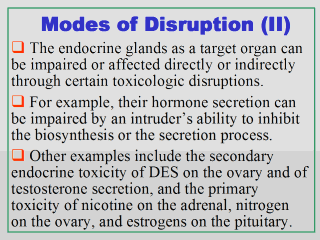| front |1 |2 |3 |4 |5 |6 |7 |8 |9 |10 |11 |12 |13 |14 |15 |16 |17 |18 |19 |20 |review |
 |
The endocrine
gland as a target organ can be impaired or affected directly through certain
toxicologic disruptions. Or such adverse effects can be a secondary response
as a result of certain actions or disruptions undertaken elsewhere in or
outside the endocrine axis. Herein endocrine toxicity and endocrine
disruption are two loosely interchangeable terms. Note that even with an
endocrine gland being a toxicological target, the primary or ultimate
concern here is with the potential production or secretion of inappropriate
amounts of hormones. A well-known case of secondary endocrine toxicity is the notorious synthetic estrogen DES that was banned worldwide mainly due to its carcinogenicity to the vagina of the userís daughter. Harvey et al. (1999) also highlight this type of toxicity with a rat study, in which increased incidences of castration cells in the pituitary were shown as a secondary response to the direct effect that had caused a reduced testosterone secretion by the ratís testes. In addition, these investigators provide a list of examples of drugs and chemicals that were seen to have caused primary endocrine toxicity. Some of their examples for primary toxicity are nicotine on the adrenal, nitrogen mustard on the ovary, and estrogens on the pituitary. The production of hormones can be impaired not only by a toxicologic effect on the secreting gland, but also by an intruding agentís ability to inhibit a specific enzymatic step required in the biosynthesis process. In addition, the production can be affected by the agentís ability to regulate at the transcriptional or translational processes. Aminoglutethimide, cyanoketone, and ketoconazole are some of the chemicals referenced (Sikka and Naz, 2002; Sikka, 1997) as having an inhibitory activity on the biosynthesis of steroid hormones in the testes. |